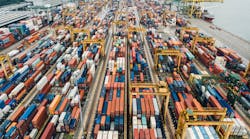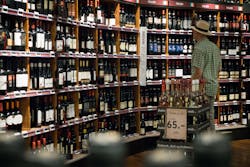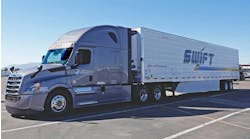As the U.S. enters the 2021 holiday season, several global industries are moving into overdrive to address increased demand.
That is especially true for the food and beverage (F&B) industry, as consumers make more food and drink purchases, and scour shelves for exotic chocolates or fine wines for loved ones. A smooth-functioning supply chain becomes even more critical to the F&B industry, and its ability to deliver on consumers’ quality and time expectations.
Although the increase in demand during the holiday season is common knowledge, multiple disruptions on the supply-chain side have complicated the issue. Disruptions like the cargo ship congestion outside the Los Angeles port highlight the strain logistics challenges can put on companies looking to deliver popular food and beverages on time.
Speed is key. Most food and beverage products are time-sensitive, and while disruptions can’t always be caught in advance, adjusting to changing conditions on the fly can help conquer challenges and unlock business value.
To work on the assumption that disruptions are inevitable, run a lean supply chain operation, and reduce financial losses, the F&B industry needs end-to-end visibility and intelligence. These aspects encompass location and condition data about the shipment. If F&B enterprises have access to real-time, multi-layer intelligence, they can plan, process, and adjust quickly to imminent disruptions.
Real-time data
Access to multi-layer, sensor-enabled supply chain intelligence in real time unlocks three key benefits that provide companies with an edge over their competitors, and deliver on quality and time promises to customers:
Shipment rescue: When firsthand location and condition data from sensors is combined with non-sensor data, users can form a better risk assessment and mitigation plan for their shipments.
For instance, if a massive shipment of ice cream is waiting at a port and its ideal temperature is not maintained, its time out of refrigeration (TOR) is rapidly increasing, ground teams can quickly notify port authorities to fast track the shipment and salvage the batch. The data points for the shipment could be a fluctuation from the ideal temperature or the threshold wait time at the port, or both—benchmarked against historic non-sensor data—triggering a warning signal.
Without access to this information in real time, and the risk of spoilage based on predictions, ground teams cannot act quickly when incidents occur. So real-time insights are imperative with mission-critical, cold chain-specific shipments that are sensitive to temperature fluctuations.
De-risking shipment nodes: Real-time condition data helps users arrange for ample stock at respective nodes if there is a problem with an OTIF (On-time and in-full shipment). When a company knows a particular item will arrive damaged, they can arrange for the damaged items or notify the customer in advance. Estimation of accurate ETA plays a significant role in the quality of delivery and customer satisfaction. If someone knows the shipment is going to be late, they can measure the potential impact and consider on-time alternatives.
For instance, if a shipment of cheese has a package-tampering incident at an airport, the responsible party can de-risk the node to avoid a stock-out situation at that customer location. Then they can order cheese from local producers to overcome shortages or fulfill the same order from another location with the inventory.
Proactively managing F&B supply chains: A minor demand ripple induced at a supermarket can have implications that amplify as it moves up a supply chain. The bullwhip phenomenon, as it’s known, presents a lot to care about.
Let's assume that cargo ships are carrying a bulk order of wine to the U.S. for the 2021 holiday season. According to media reports, this consignment will arrive later than expected. It leads to increased panic buying at local stores, which leads to a demand vacuum; by the time the company produces more wine and ships the commodity, the demand is no longer present. It then leads to production cuts, leading to scarce delivery in the next cycle until another surge.
To counter the bullwhip effect, companies can have more wine shipped via a faster route and can quickly fill in the vacuum. This saves the manufacturing units from working overtime and minimizes the impact of the effect.
But is location and condition data all that’s ever needed? Of course not.
Multi-layer intelligence
Access to location and condition data in real time is not enough. As companies move toward building a complete digital twin of their F&B supply chain, they also need multi-layer intelligence—from a micro to a macro level. This level of detail in a real-time visibility solution allows users to zoom in and out of their supply chain, offering greater control and foresight into disruptive events.
When researching real-time visibility solutions, must make sure they brings three layers of intelligence.
First layer: Including bringing shipment-level intelligence, this layer is about parameters like ETA changes, temperature risks, security risks, dwell time at ports, or missed connections. This layer can be termed as the one that provides information about the location and condition of a shipment. It helps pinpoint the root cause of the problem, which may occur at a shipment level or an item level.
Second layer: The second layer consists of lane- and vendor-level intelligence. It deals with data around specific delivery routes, congestion on the course, and the possible events that could influence the delivery of products.
Third layer: The third layer includes data point indicators for network-level intelligence. This area offers high-level insight for an entire F&B supply chain over significant periods at nodes, regions, or globally. Think of it as climate prediction. The weather department can forecast using data sets if California will have a long or short summer in the coming year and the probability of forest fires in the upcoming season.
An example of a meat delivery operation from Brazil to the UAE encapsulates all three layers of intelligence. The shipment-level intelligence comes from firsthand sensor data on the location and condition of each shipment. It delivers clear indicators of the shipment’s health and the insight to act upon any unplanned excursions happening at ports or in transit. Depending on its criticality, the future meat shipment can take a proper lane with a better score, deduced from verified historical non-sensor data.
Lane-level intelligence helps predict ETA before the journey begins and aids in long-term supply chain planning. It’s crucial to OTIF shipments and helps keep track of supplies that come in on-time, in-full, and in-condition from Brazil to a distribution center in the Middle East. A delay in the delivery of meat shipments via a lane affects the entire operation of the F&B supply chain and must be kept in check.
The third layer of intelligence is where the meat company can predict the future stock levels and health at a specific distribution center. This layer is all about knowing the exact usable stock they will have at each distribution center in United Arab Emirates based on lane, nodal, and shipment network effects over the next few weeks or months.
Visibility is vital
F&B supply chains are highly fragile and require location and condition visibility with multi-layer intelligence.
An ideal visibility solution provides all micro- and macro-level points on a shipment, lane, and network level, respectively. It enables prompt decisions and gives businesses an edge over the competition. Most visibility solutions in the F&B industry offer the layers of intelligence but miss out on the accuracy and timeliness of data for it to be actionable.
To address the data’s accuracy and timeliness at the micro and macro level, the Roambee team focuses on bringing together three key elements—firsthand sensor data, leveraging non-sensor data to offer context, and using artificial intelligence to bring out precise insight and foresight.
There are a lot of solutions that offer lane-level and network-level intelligence, too. Yet, in the absence of firsthand, item-level visibility and intelligence, this information can’t be used to understand the condition of a shipment with certainty and make bold decisions.
With many options in the supply chain-visibility space, increased customer demand for farm-to-fork traceability, and U.S. Food and Drug Administration initiatives on the same, food supply chain professionals need to reassess if they have the proper real-time visibility and multi-layer intelligence to run a proactive and agile food supply chain.




